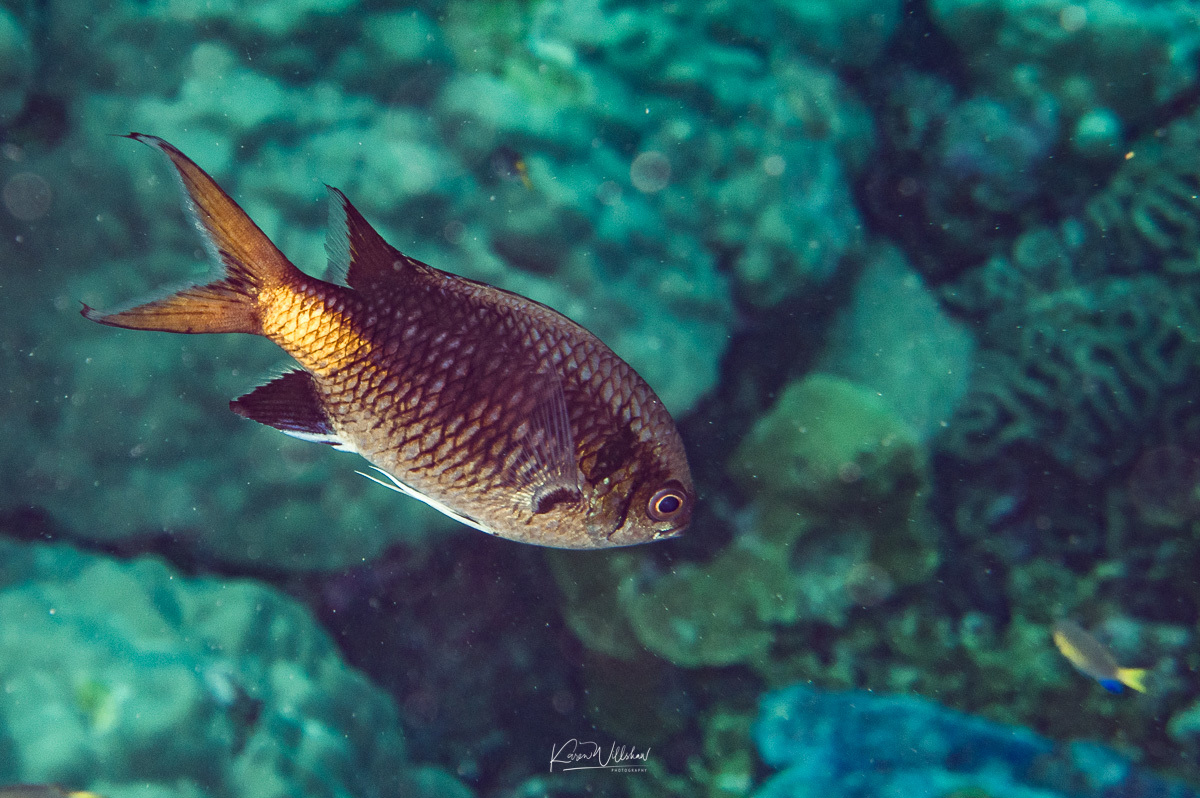- Classification
- ACTINOPTERYGII
- PERCIFORMES
- POMACENTRIDAE
- Chromis
- opercularis
Doublebar Chromis, Chromis opercularis (Günther 1867)
Other Names: Lightning Double Bar Chromis

A Doublebar Chromis, Chromis opercularis, at the Cabbage Patch, Cocos (Keeling) Islands, March 2016. Source: @cocos_karen / iNaturalist.org. License: CC By Attribution-NonCommercial
Summary:
A silvery-grey to a bronzy-brown chromis with a dark bar on the gill cover behind the eye, a broad dark bar behind the head running onto the pectoral-fin base, dark-edged scales, a dusky to brownish tail, often with a yellow caudal peduncle, and a broad pale or transparent margin on the dorsal and anal fins. Juveniles are silvery-blue with elongate yellow caudal-fin lobes.
In the Australian EEZ, this species in known only from Cocos (Keeling) Islands and Christmas Island in the eastern Indian ocean.
In the Australian EEZ, this species in known only from Cocos (Keeling) Islands and Christmas Island in the eastern Indian ocean.
Cite this page as:
Bray, D.J. 2023, Chromis opercularis in Fishes of Australia, accessed 27 Jun 2025, https://fishesofaustralia.net.au/home/species/4953
Doublebar Chromis, Chromis opercularis (Günther 1867)
More Info
|
Distribution |
Cocos (Keeling) Islands and Christmas Island in the eastern Indian Ocean, AUS EEZ. Elsewhere the species is widespread in the Indo-west Pacific: East and South Africa, east to Christmas Island and western Indonesia. Inhabits outer reef slopes and deep lagoons often around oceanic islands, usually forming aggregations well above the seafloor. |
|
Features |
Dorsal fin XIII, 10-11; Anal fin II, 10-11; Pectoral fin 18–20; Upper and lower procurrent caudal-fin rays 3; lateral-line scales (pored) 17-18; Gill rakers 6–8 + 19–22 = 26–30. Longest dorsal-fin soft ray length 24.6–36.4% of SL; first anal-fin spine length 6.5–8.4% of SL; caudal-fin length 43.9–59.8% of SL; posterior tips of caudal-fin lobes filamentous. |
|
Colour |
broad black bands along preopercular and opercular margins, sum width of two bands 15.3–27.9% (23.6%) of head length; distal half of soft-rayed portion of dorsal fin transparent in adults; no triangular black blotches at upper or lower caudal-fin base; caudal peduncle and fin tinged with yellow; soft-rayed portions of dorsal and anal fins yellowish, but spinous portion of dorsal fin and pelvic fin dark blue in juveniles. |
|
Remarks |
The Doublebar Chromis is replaced in Réunion and Mauritius by Chromis torquata Allen 2018. |
|
Similar Species |
Differ from the similar Pale-tail Puller, Chromis xanthura, in having a well-defined broad dark bar on the rear of the gill cover that extends onto the pectoral-fin base (vs. a narrower and less-defined blackish bar). Adult C. xanthura usually have a white tail and caudal peduncle (occasionally a dark tail), while adult C. opercularis have a dusky-grey to brownish tail, often with a yellowish caudal peduncle. Both species occur at Cocos (Keeling) Islands and Christmas Island in the eastern Indian Ocean. Juveniles of both species are very similar and difficult to tell apart. |
|
Etymology |
The specific name opercularis is from the Latin operculum (= cover, lid) in reference to large irregular black patch on the rear of the gill cover. |
|
Species Citation |
Heliastes opercularis Günther 1867, Fishes of Zanzibar: 84, Pl. 11 (fig. 2). Type locality: Zanzibar, Tanzania, western Indian Ocean |
|
Author |
Bray, D.J. 2023 |
|
Resources |
Doublebar Chromis, Chromis opercularis (Günther 1867)
References
Allen, G.R. 1986. Family 219: Pomacentridae. pp. 670-682 in Smith, M.M. & Heemstra, P.C. (eds). Smith's Sea Fishes. Johannesburg : Macmillan South Africa xx + 1047 pp. 144 pls.
Allen, G. R. 2001. Family Pomacentridae. pp. in Carpenter, K.E. & Niem, T.H. (eds). The Living Marine Resources of the Western Central Pacific. FAO Species Identification Guide for Fisheries Purposes. Rome : FAO Vol. 6 pp. 3381-4218.
Allen, G.R. 2018. Chromis torquata, a new species of damselfish (Pomacentridae) from Mauritius and Réunion. aqua, International Journal of Ichthyology 24(1): 15-22. See ref online
Allen, G.R. 2022. Chromis opercularis. The IUCN Red List of Threatened Species 2022: e.T188597A1899611. https://dx.doi.org/10.2305/IUCN.UK.2022-2.RLTS.T188597A1899611.en. Accessed on 21 September 2023.
Allen, G.R. & Erdmann, M.V. 2012. Reef fishes of the East Indies. Perth : Tropical Reef Research 3 vols, 1260 pp.
Allen, G.R. & Smith-Vaniz, W.F. 1994. Fishes of Cocos (Keeling) Islands. Atoll Research Bulletin 412: 1-21
Allen, G.R., Steene, R.C. & Orchard, M. 2007. Fishes of Christmas Island. Christmas Island : Christmas Island Natural History Association 2 edn, 284 pp.
Hobbs, J-P.A., Newman, S.J., Mitsopoulos, G.E.A., Travers, M.J., Skepper, C.L., Gilligan, J.J., Allen, G.R., Choat, H.J. & Ayling, A.M. 2014. Checklist and new records of Christmas Island fishes: the influence of isolation, biogeography and habitat availability on species abundance and community composition. Raffles Bulletin of Zoology Supplement 30: 184–202
Hobbs, J-P.A., Newman, S .J., Mitsopoulos, G.E.A., Travers, M.J., Skepper, C.L., Gilligan, J.J., Allen, G.R., Choat, H.J. & Ayling, A.M. 2014. Fishes of the Cocos (Keeling) Islands: new records, community composition and biogeographic significance. Raffles Bulletin of Zoology Supplement 30: 203–219
Motomura, H., Nishiyama, H. & Chiba, S.N. 2018. Review of the Chromis xanthura species group (Perciformes: Pomacentridae), with description of a new species. Ichthyological Research 65: 177-191 https://doi.org/10.1007/s10228-017-0601-8
Playfair, R.L. & Günther, A. 1867. The fishes of Zanzibar, with a list of the fishes of the whole east coast of Africa. London pp. i-xix + 1-153, pls 1-21.





